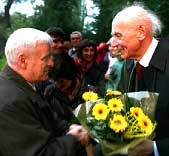On the Genesis of the Sinfonia de motu (Symphony on Motion)
Jerzy Warczewski
On September 12, 2005, the opening day of the Congress of Polish Physicists, a concert for its participants took place in Warsaw in the National Philharmonic. During this evening performance was the world premier of a symphony by Wojciech Kilar, a famous Polish composer born in 1932. The symphony was written to commemorate the World Year of Physics 2005 and was performed by the Warsaw Philharmonic National Orchestra of Poland, soloists, singers and chorus.
At the end of February 2004 I asked Wojciech Kilar to write a piece of music on the occasion of the World Year of Physics 2005. Before I went to him I realized that I could not go with my hands empty, and I took with me a musical theme based on the notes whose letter symbols are identical with the letter notation of fundamental physical constants and concepts: c – speed of light, h – Planck’s constant (represented by B in the English musical scale), G – gravitational constant, e – elementary charge and at the same time the first letter of the name Einstein, and finally a – the first letter of the word atom. When I gave these five notes, C, B, G, E, A to Kilar, I emphasized that this sequence is not bindingI gave a short definition of these symbols to the Maestro and mentioned that we were celebrating the hundredth anniversary of the publication of the legendary papers in which Einstein laid the foundations for the special theory of relativity, quantum physics and the theory of Brownian Motion. He was fascinated by my explanation of Brownian Motion, the constant motion of particles in the microworld, and inspired by this idea devoted the entire symphony to motion and named it in Latin Sinfonia de motu (Symphony on Motion). Finally on March, the 6th, 2005 he phoned to tell me he had completed the composition and dedicated it “To the Polish Physicists in the World Year of Physics 2005.”

Professor Warczewski congratulates Wojciech Kilar (right) after a concert of his music compositions in Katowice, Poland
(Photo by Arkadiusz Ławrywianiec, www.areklawrywianiec.com)
Sinfonia de motu is a four-movement composition lasting one hour. In the fourth movement, the choir and the two soloists, soprano and baritone, join the orchestra. The soloists also sing in the second and third movements. The words are from the Divine comedy by Dante Alighieri. The musical theme is a kind of “music of the spheres”. A few months after completing the Symphony, Kilar said to me: “This is my Ninth Symphony.” Of course, the point was that as in Beethoven’s Ninth Symphony, there is a Finale with the choir and the soloists. In Beethoven’s Symphony words are by Friedrich Schiller, Ode an die Freude, whereas in Kilar’s, the title words of Dante, paraphrased in German are Ode an die Liebe. Kilar was able to express from Dante’s text, “La gloria di colui che tutto move…” the fascination with motion.
The Symphony on Motion premiered on the evening of the first day of the Polish Physical Society meeting in 2005. The composer said that “his idea of the symphony is to combine two perceptions of the World and to confront in music a purely physical concept of motion with that based on Dante’s understanding of divine motions and their Creator.”
Dante writes about love, which moves the Sun and other stars, and there is also luce etterna, eternal light. Kilar considers this symphony as the most religious musical piece among his compositions. It is extremely interesting that he has gone this way, although in our first meeting in which I proposed writing a symphony to him, he announced, that I had come at a propitious time on his creative path, because he was fed up with composing religious and patriotic music, while the idea of writing this symphony immediately inspired him. He expressed this thought many times during the entire creative process, as well as after completing the composition and after its first performances. However, it is now clear that his genius led him, contrary to his initial feelings and intentions, once again into the fields of philosophy, theology and religion. Indeed, the depth of this composition seems to be related to the composer’s philosophical and theological vision of his work, as well as of the whole world.
Professor Jerzy Warczewski is on the faculty of the Institute of Physics, University of Silesia Katowice, Poland and editor-in-chief of Advances in Physics, the bimonthly journal of The Polish Physical Society.
Disclaimer - The articles and opinion pieces found in this issue of the APS Forum on International Physics Newsletter are not peer refereed and represent solely the views of the authors and not necessarily the views of the APS.
